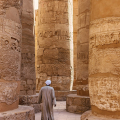KARNAK TEMPLE
Go there and contact
Here you are at one of Egypt's most famous sites, and you're in for a thrill...
Jean-François Champollion wrote: "At last I went to the palace, or rather the city of monuments, at Karnak. There appeared to me all the magnificence of the Pharaohs, all that men have imagined and executed of the greatest. (...) All that I had admired with enthusiasm on the left bank, seemed to me miserable in comparison with the gigantic conceptions with which I was surrounded... Suffice it to say that we in Europe are no more than Lilliputians, and that no people, ancient or modern, has conceived the art of architecture on so sublime a scale, so broad, so grandiose, as did the ancient Egyptians."
Its grandiose dimensions (around 1.5 km long and 700 m wide) and the tangle of its buildings make it look more like a city than a simple temple! The temple was the world's largest religious complex, and the site originated on a sacred spot, the sacred hill, from which, according to the ancient Egyptians, the world was built. Several pharaohs sought to build temples in their own image, and the complex was extended many times. Recent developments have sought to restore the relationship between the first pylon and the Theban mountain; the trees have been cut down, and in their place an immense pavement of polished granite has been laid...
Karnak as a whole, vast, dense and bushy, cannot be revealed at a glance. In itself, it would deserve a place that would exceed the limits of this guide. For this reason, we strongly advise amateurs to enlist the services of a qualified guide. As for the others, they should let their gaze linger on these innumerable wonders as they please, without trying to see and understand everything, as this is impossible in just one or a few hours.
The temple is made up of several distinctsections: Montu (in ruins) to the north, Mut to the south and, between the two, the great temple of Amun, by far the most interesting part.
In front of the first pylon, preceded by sphinxes, was the original landing stage, of which two ramps remain. This first pylon, never completed, was one of the last constructions undertaken at Karnak. All the pylons you'll come across on your way were, at one time or another, the outer limits of the complex, which were constantly being extended.
In the main courtyard, on your left, the small temple of Sety II is dedicated to the Amun-Mut-Khonsu triad, which at the time of its construction was outside the enclosure. To the right is the temple of Ramses III, with some very realistic bas-reliefs on the walls.
Oncepast the second pylon , a forest of 134 columns appears. It's a titanic work, begun under Amenophis III. This pharaoh was responsible for the erection of the twelve columns of the central nave (23 m high and with capitals able to accommodate more than forty people standing!). Successive kings, notably Seti I and Ramses II, completed the beautiful edifice. The hall (102 m x 53 m) originally had a ceiling.
Between the third and fourth pylons lies the court of Amenophis III. Only one of the four obelisks, once in place, remains. Turning right, you enter a courtyard known as "the hiding place", where phenomenal quantities of stone and bronze statuettes (over ten thousand in all) were found, deposited there by the priests. It was unthinkable to destroy a representation of a god or his son, Pharaoh. The next courtyard contains the base of an impressively large obelisk, measuring 3.20 m on each side (Hatshepsut's obelisk measures "only" 2.60 m). To your left, against the backdrop of the sound and light stages, the greenish waters of the sacred lake, where ritual navigations took place, shimmer. You can't help but stop in front of the large scarab carved into the granite, dedicated to the god Atoum-Khepri.
Beyond the fourth pylon, an obelisk erected by Queen Hatshepsut towers 30 m above the surrounding buildings. Originally, there were two obelisks, their tops covered in gold.
Beyond the sixth and final pylon, a small courtyard gives access to the sanctuary, preceded by two imposing pink granite pillars decorated with the emblems of Lower and Upper Egypt.
The sanctuary, also in granite, was built quite late under Philip Arrhidaios (323). It served as a resting place for sacred boats. The next courtyard (former site of the primitive sanctuary, of which nothing remains) leads to the festival hall of Thoutmes III. Transformed into a church by the Christians, one of its few pillars still bears traces of ancient paintings. The best-known of the solar halls is the "botanical garden", with its exotic flowers and animals.
Adjacent to the northern enclosure is the small temple of Ptah built by Thutmes III, one of whose three sanctuaries houses a black granite statue of Sekhmet.
Did you know? This review was written by our professional authors.
Members' reviews on KARNAK TEMPLE
The ratings and reviews below reflect the subjective opinions of members and not the opinion of The Little Witty.















A visiter absolument!!!
La visite de nuit avec le spectacle n'est pas si intéressante que ça, malgré l'audio-guide. Mais elle permet de prendre de belles photos.